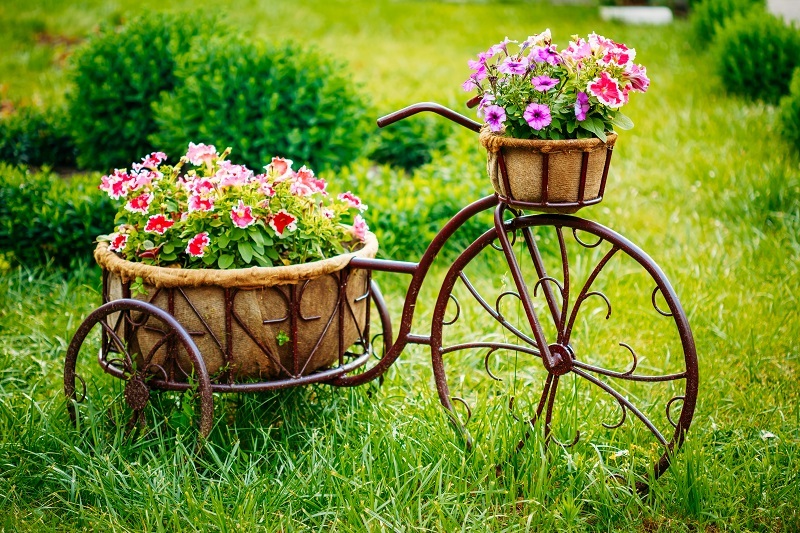Master the Art of Hydrangea Care for Stunning Garden Views
Posted on 18/08/2025
Master the Art of Hydrangea Care for Stunning Garden Views
Hydrangeas are among the most beloved blooms for gardeners worldwide. Their spectacular clusters of pastel-colored flowers and lush green leaves make them the focal point of any garden. But growing truly breathtaking hydrangeas requires more than simply planting and watering. Mastering hydrangea care will ensure your garden becomes a seasonal showcase of captivating color and abundant blooms. This comprehensive guide covers everything you need to know to nurture vibrant hydrangeas for stunning garden vistas.
Understanding Hydrangea Varieties
Before delving into hydrangea care, it's important to identify the type of hydrangeas you have or want to grow. Each variety has its own unique needs and charms.
Main Types of Hydrangeas
- Bigleaf Hydrangea (Hydrangea macrophylla): Known for large, globe-shaped flowers in pink, blue, or purple, depending on soil pH.
- Panicled Hydrangea (Hydrangea paniculata): Features cone-shaped white blooms that fade to pink or green, extremely cold-hardy.
- Oakleaf Hydrangea (Hydrangea quercifolia): Recognizable by oak-shaped foliage and elongated flower clusters that turn from white to rosy-pink.
- Smooth Hydrangea (Hydrangea arborescens): Best known for 'Annabelle' with massive white flower spheres, adaptable across climates.
- Climbing Hydrangea (Hydrangea petiolaris): Clings to walls and trellises, showing off creamy white lacecap blooms.
Knowing your hydrangea type is critical: it affects everything from pruning techniques to blooming periods and preferred sun exposure. Proper cultivation and care start with understanding the traits of your hydrangea's variety.

Planting Hydrangeas for Garden Success
Choosing the Best Site
Hydrangeas thrive in partial shade, ideally with morning sun and afternoon shade. Too much direct sunlight can scorch leaves, while deep shade can inhibit blooming. Consider these factors for choosing the right spot:
- Soil Drainage: Hydrangeas dislike soggy roots. Plant them in well-draining soil enriched with organic matter.
- Air Circulation: Ensure enough space between plants for good air movement, reducing the risk of diseases.
- Aesthetic Placement: Place hydrangeas where their blossoms can be admired from patios, windows, or garden paths.
Planting Steps for Hydrangea Success
- Dig a hole twice as wide as the root ball and just as deep.
- Amend the soil with compost to enhance fertility and drainage.
- Set the plant in the hole, making sure the crown is at ground level.
- Backfill and mulch around the base to retain moisture and suppress weeds.
- Water thoroughly after planting, and keep soil consistently moist (not waterlogged) as roots establish.
Hydrangea Care Guide: Nurturing Healthy, Vibrant Blooms
Watering for Hydrangea Health
- Consistent moisture is essential, especially during dry spells.
- Deep watering is preferable to frequent, shallow watering--aim to soak the root zone.
- Mulch hydrangea beds 2-3 inches thick to conserve moisture and keep roots cool.
- Avoid overhead irrigation; water at the base to prevent leaf spot and mildew.
Pro Tip: If your hydrangea leaves wilt, check soil moisture before watering, as both over and under-watering can cause droopiness.
Fertilizing Hydrangeas for Optimal Growth
- Fertilize hydrangeas once in early spring, using a balanced, slow-release fertilizer or one made specifically for flowering shrubs.
- Bigleaf varieties benefit from light feeding in late spring if blooms are sluggish.
- Too much nitrogen encourages leafy growth at the expense of flowers--don't overdo it!
Pruning Hydrangeas: When and How for the Best Results
- Bigleaf and Oakleaf Hydrangeas: Prune immediately after flowering. Remove dead blooms and weak stems, but avoid heavy pruning which can remove next year's flower buds.
- Panicled and Smooth Hydrangeas: These bloom on new wood. Prune late winter or early spring before growth begins.
- Remove dead, damaged or crossing branches at any time to improve shape and air circulation.
Proper pruning is an essential part of hydrangea maintenance. It ensures better blooming, plant shape, and overall vigor year after year.
Achieving Spectacular Flower Color: Manipulating Hydrangea Blooms
One of the most fascinating aspects of hydrangeas is the ability of some types, especially Bigleaf hydrangeas, to change color based on soil pH:
- Acidic soil (pH under 6): Produces blue flowers
- Neutral to alkaline soil (pH above 7): Produces pink to purple blooms
You can influence color by amending your soil:
- For blue flowers: Add aluminum sulfate or garden sulfur to lower pH
- For pink flowers: Add lime to raise pH
Note: White hydrangeas do not change color with soil pH.
Tips for Vivid Hydrangea Colors
- Test your soil pH before making amendments.
- Be patient--color changes can take a full growing season to appear.
- Avoid over-fertilizing, as excess nutrients can dilute color vibrancy.
Hydrangea Care Through the Seasons
Spring
- Prune (only if variety requires it in spring).
- Apply slow-release fertilizer.
- Mulch renewal.
- Monitor for new shoots--beware of late frosts on emerging buds, especially for Bigleaf types.
Summer
- Deep water regularly during dry spells.
- Remove spent flowers to encourage new blooms.
- Watch for pests or powdery mildew.
Fall
- Allow spent blooms to remain for winter interest (especially Panicle and Oakleaf types).
- Reduce watering as plants go dormant.
- Apply compost or mulch for winter protection.
Winter
- In colder regions, protect the base of hydrangeas with extra mulch or burlap.
- Avoid heavy pruning until spring for varieties that bloom on new wood.
- Keep beds free of fallen leaves and debris to prevent disease.
Common Hydrangea Problems and Solutions
Pests
- Aphids: Blast with water or use insecticidal soap.
- Spider mites: Increase humidity around the shrub and treat with horticultural oil if needed.
- Slugs/snails: Apply barriers or use bait as necessary.
Diseases
- Leaf spot: Avoid overhead watering, space plants for air flow, and remove infected leaves.
- Powdery mildew: Improve air circulation and apply fungicides if severe.
- Root rot: Always plant in well-drained soil and avoid waterlogged conditions.
Blooming Issues
- No blooms: Frost might have killed bud, or improper pruning may have removed flower buds. Some types need maturity before blooming profusely.
- Small or faded blooms: Nutrient deficiency, over-fertilizing, or poor soil health. Reassess fertilizing and amend soil if needed.
Creative Hydrangea Garden Design Ideas
Hydrangeas aren't just beautiful as standalone shrubs--they're versatile stars in many garden styles. Consider these ideas to maximize your garden's beauty:
- Hedge or border: Line a path or property edge with matching hydrangeas for a vibrant boundary.
- Mixed shrub beds: Combine with roses, daylilies, and evergreens for year-round interest and bloom succession.
- Woodland plantings: Underplant Oakleaf or Bigleaf hydrangeas with hostas, ferns, and astilbe for a lush, layered look.
- Containers: Dwarf hydrangeas work exceptionally well in pots to brighten patios and decks.
- Vertical accents: Train climbing hydrangea up a trellis, wall, or mature tree for dramatic vertical interest.

Frequently Asked Questions About Hydrangea Care
Q: When is the best time to plant hydrangeas?
A: The best time to plant hydrangeas is in spring or fall, avoiding the heat of summer and freezing winter. This allows roots to establish before facing extreme weather.
Q: Can hydrangeas grow in pots?
A: Yes! Many compact or dwarf hydrangea varieties flourish in containers. Use a large pot with drainage and potting mix formulated for shrubs.
Q: How do I keep my hydrangea blue?
A: Maintain acidic soil (pH 5.2-5.5) by applying aluminum sulfate. Test soil regularly and avoid lime.
Q: Should I deadhead hydrangeas?
A: Deadheading spent flowers is beneficial for aesthetics and sometimes encourages rebloom, but leave spent blooms through fall if you want winter interest, especially for panicle and oakleaf types.
The Joy of Mastering Hydrangea Care
With the right knowledge and careful attention, anyone can cultivate jaw-dropping hydrangea displays. From selecting healthy plants and ideal locations to fine-tuning watering, pruning, and fertilizing routines, your effort pays off in lush foliage and abundant, colorful flowers. Experiment with soil amendments to fine-tune bloom hues and create dynamic landscape vistas.
Remember: Hydrangea maintenance is a rewarding process that connects you with the rhythm of the seasons and the delight of ever-changing blooms. Whether you're a novice or a seasoned gardener, mastering hydrangea cultivation will transform your garden into a paradise of stunning views and lasting memories.
Now is the perfect time to start your hydrangea journey--plant, nurture, and watch as your garden becomes a masterpiece of color and grace, year after year!
Latest Posts
A Dozen Long-Lasting Blooms for the Enthusiast
Fragrant Therapy: Boosting Your Mood with Floral Beauty
Master the Art of Hydrangea Care for Stunning Garden Views
The Enchanting Allure of Red Roses on Valentine's Day
Gaining Deeper Understanding Through Your Birth Flower's Symbolism





